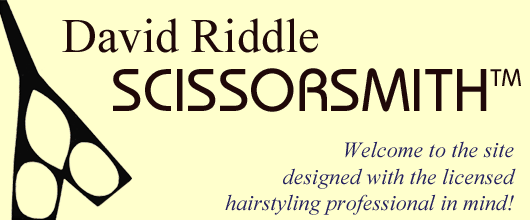 |
 |
| P.O. Box 146, Saluda, NC 28773 • (828) 749–1002 • david@scissorsmith.com |
| HOME | SCISSORS CARE | SELECTING | SHARPENING | MYTHS & FACTS | FAQ |
Important Factors to Consider When Purchasing Quality Scissors |
Scissors are manufactured with a variety of features. All of the choices may seem a little confusing at first. To see through the myriad of options, consider the following: REQUIREMENTS: Determine how you plan to use the scissors. Consider these factors: will they be used to cut wet or dry hair, for precision cutting, scissors over comb, weight–lines, or bobs? Will they be primary use scissors, or back–ups? Once you determine their place in your scissors portfolio, you can then evaluate the following factors: EDGE: Consider a honed edge vs. a machined–serrated edge. The machined–serrated edged scissors are more durable. They are ideal for beard trims, mannequin cuts, dry cuts, etc. On the other hand, the honed–edge scissors, while less durable, gives superior results when used on clean shampooed–wet hair. Honed–edge scissors are generally more expensive and require greater care, but cut better and have a longer useful life. FINGER REST: Using a finger rest is a personal choice. Some advocates suggest that it helps prevent dropping and reduces fatigue. Others say it reduces the incidence of wrist problems like carpal tunnel syndrome. Opponents say it gets in the way. If you are not sure which you prefer, some scissors are available with screw–in rests so you can have your scissors with or without a rest, and change it if you wish. LENGTH and LOOPS: Correct blade length varies with the intended use of the scissors, the way you hold it, and your hand size. Precision cutting normally calls for shorter (4.5 to 5.5 inch) scissors, while scissors-over-comb work, cutting weight lines and bobs generally require longer (6.0 to 7.5 inch) scissors. Buying the right size scissors is a very important component of your long term satisfaction. EVENNESS: How a blade feels as you open and slowly close the blades can tell you a lot about the scissors quality. As you open and close the scissors notice the evenness of the pressure of the blades on each other. Spots that feel loose or tight can indicate poor quality and/or misaligned blades. Superior quality is generally indicated by an even, moderate pressure from the fulcrum to the tips. Also be aware of the smoothness of the blades. Rough spots or a gritty feel on honed edge scissors indicate poor quality or damaged edges. You will, however, be able to feel the serration on scissors with a machined–serrated edge. CONFIGURATION: Configuration means how the loops are aligned in relation to each other. Scissors are available in even loop, offset, and crane styled models. The appropriate style for you depends on: your personal preference, which fingers you use to hold the scissors (middle or ring finger), and your individual cutting style. Buy whatever style feels most comfortable. TIPS: Smooth, slightly pointed tips can be more comfortable to the client and allow you to get under the hair easier when cutting outlines against a client's neck. Some stylists prefer blunter tips which can help minimize cutting fingers. Rough tips can be an indicator of poor quality. SERVICE: Quality scissors are an expensive long–term investment. Make sure that your investment is backed up by a qualified source of service that will provide superb sharpening, fast turnaround, and factory parts at a reasonable cost. Like any other art or craft, excellent sharpening is the end result of a combination of skill, knowledge, talent, and proper specialized equipment. Don't cheat yourself by going for the cheapest or drop–by sharpening. Your scissors are only as good as their last sharpening. |
| HOME | SCISSORS CARE | SELECTING | SHARPENING | MYTHS & FACTS | FAQ |
| Copyright © 2008-2015 David Riddle, Scissorsmith. All rights reserved. |